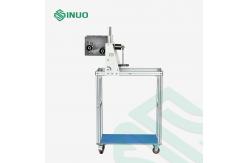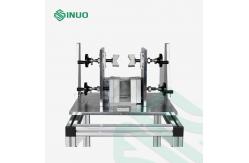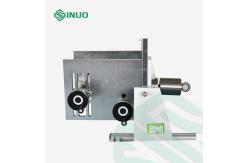Electric Vehicle Withdrawal Force Latching Verification Test Apparatus IEC62196
|
|
IEC62196 Electric Vehicle Withdrawal Force And Latching Verification Test Apparatus
Complied Standards & Clauses
IEC 62196-1:2020 clause 14.1.5, 14.1.6, fig13, fig14. IEC 62196-1:2014 clause 17.2.
Equipment Overview
This test equipment conforms to IEC 62196-1:2020 clause 14.1.5, 14.1.6, fig13, fig14. IEC 62196-1:2014 clause 17.2. It is used to check the maximum force required when the test plug is withdrawn from the socket-outlet or vehicle connector and the minimum force required when the single-stage pin is pulled out of the socket. It is also used to verify the design of contact tubes can ensure adequate contact continuity before and after a number of operations corresponding to their operational life.
Technical Parameters
A Maximum withdrawal force The maximum withdrawal force of the socket-outlet shall meet the requirements of Table 1. Apply the maximum withdrawal force specified in the standard (total force of the principal weight, supplementary weight, hook (clamping device) to the test plug, when the supplementary weight is dropped from a height of 50mm, the plug should come out of the socket. User should select an appropriate weight for the test according to the following table:
B Minimum withdrawal force Insert the gauge with the minimum withdrawal force specified in the standard (that is, the test pin (single pin) that meets the requirements of this standard, the total mass of the pin should be equal to the value specified in the table) into each individual socket in the socket-outlet. The gauge must not be removed from the socket within 30 seconds.
C Structure features This device is mainly composed of the installation fixture, the clamping device, principal weight, supplementary weight and the test plug. Based on experience, the pull clamp is changed to a counterweight, the weight hook is directly connected to the test plug, and the fixture for holding the sample is configured. The specific shape is shown in figure 1.
D Test plug The test plug, according to the relevant standard sheets, shall have finely ground contacts of hardened steel, having a surface roughness not exceeding 0,8 µm over their active length and spaced at the nominal distances, with a tolerance of ±0,05 mm. The dimension of the plug contacts or the distance between contact surfaces for other types of plug contacts shall be in accordance with the minimum dimension(s) given in the relevant standard sheets, with a tolerance of +0,010mm The test plugs are not included in this test apparatus, please use those test plugs that client already ordered separately as following:
E Test pins The test pins are not included in this test apparatus, please use those test pins that client already ordered separately as following:
|
|||||||||||||||||||||||||||||||||||||||||||||||||||||||||||||||||||||||||||||||||||||||||||||||||||||||||||||||||||||||||||||||||||||||||||||||||||||||||||||||||
| Product Tags: EV Withdrawal Force Latching Device IEC62196 Withdrawal Force Latching Device EVSE Latching Verification Test Apparatus | |||||||||||||||||||||||||||||||||||||||||||||||||||||||||||||||||||||||||||||||||||||||||||||||||||||||||||||||||||||||||||||||||||||||||||||||||||||||||||||||||

|
EV Charging Connector Flexibility Testing Equipment Durability Tester IEC 62196 |

|
EV Plug Durability Tester Vehicle Charging Connector Flexibility Testing Apparatus |

|
Automatic Hydraulic Pressure Testing System PLC Hydraulic Test Bench |

|
EV Charging Interface Test Equipment Mechanical Endurance Test Machine |

|
Computer Controlled Pressure Testing Automotive Hydrostatic Test Equipment |

|
EVSE Testing Equipment EV Connector Test System Electric Vehicle Cable Tester |




